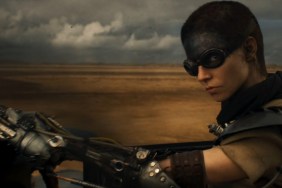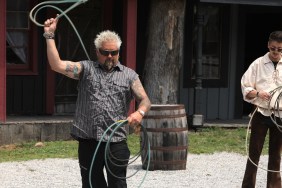By now, youre likely used to the Alamo Drafthouses brand of moviegoing. Dont talk. Dont text. Dont blow it. If so, youre also used to and anticipate their Dont Talk PSAs, mini briefings that either sharply or humorously repurpose older films, or talk to new filmmakers and performers, to spread the good word of good moviegoing. Their latest just might one of the best as Mad Max master George Miller and twice-over villain Hugh Keays-Byrne lay down the law of the wasteland.
In the video, Keays-Byrne is genuinely intimidating. This is a testament to performance and magnetism, even on a small scale such as this.
Im also posting this video because this weekends Mad Max: Fury Road isnt necessarily a horror film, but with the series ties to cult cinema, ozploitation and punk subculture, I wanted to open a space to discuss it.
Its incredible.
Fury Road is essential. What Miller has crafted is pure cinema, a gift of spectacle. Fury Road is sound and vision and metal and flesh and rejection of the status quo. It imparts its ideasexhilarating, furiously feminist onesthrough image and stunning, colorful movement. Fury Road is at once meticulously designed and yet feels ever-unhinged, like The Road Warrior does. It is a world with rich character and history, which thankfully refuses to be imparted through endless verbal exposition.
Keays-Byrne returns to the series (he was of course Toecutter in Mad Max) as the ghastly Immortan Joe, a warlord of the wasteland who promises eternal life in Valhalla to his mindless Warboys and keeps a harem of breeders, controlling the reproductive rights of women. He also releases water, at fickle will, to the poor, starving denizens that surround his Citadel. He is a repulsive old man who deigns to dictate lifes most basic elements.
As Imperator Furiousa, Charlize Theron rejects such. On a supply run, with a massive, armed truck, she absconds with Joes five wives. Max, serving as a blood bag for one Joes of boys (Nux, played by Nicholas Hoult) is swept up in the rebellion, as a battalion of soldiers and vehicles chase the women down.

Fury Roads story is its propulsive chase across the desert and this ravaged world. Max, as the insane, reluctant aid, witnesses the forming of Furiousa, an utter goddess, and the five wives (The Splendid Angharad, The Dag, Capable, Toast the Knowing, Cheedo) in motion. Similar is the surprising arc of Nux, whose ignorance of nature and willingness to die for Joe forms the films co-refusal of religion as both war tactic and bestowing of afterlife rewards. Again, this is in perpetual, invigorating motion that feels too fast, too powerful for authority catch, hold and stop. Fury Road is idiosyncratic and insane in its imagery, a denial of corporate sheen in favor of saturated lunacy, Joes battalion a vision of uncivilized idiocy (especially that fucking guitar player).
Fury Road was of course a rigorous process of production and editing. It also a Warner Bros. production that cost north of $150 million. So its not as if it was hidden from sight and released as a surprising object of protest. The miracle is that it feels like such. It feels radical in its political thought and outright dismissal of typical Blockbuster branding. See it.









